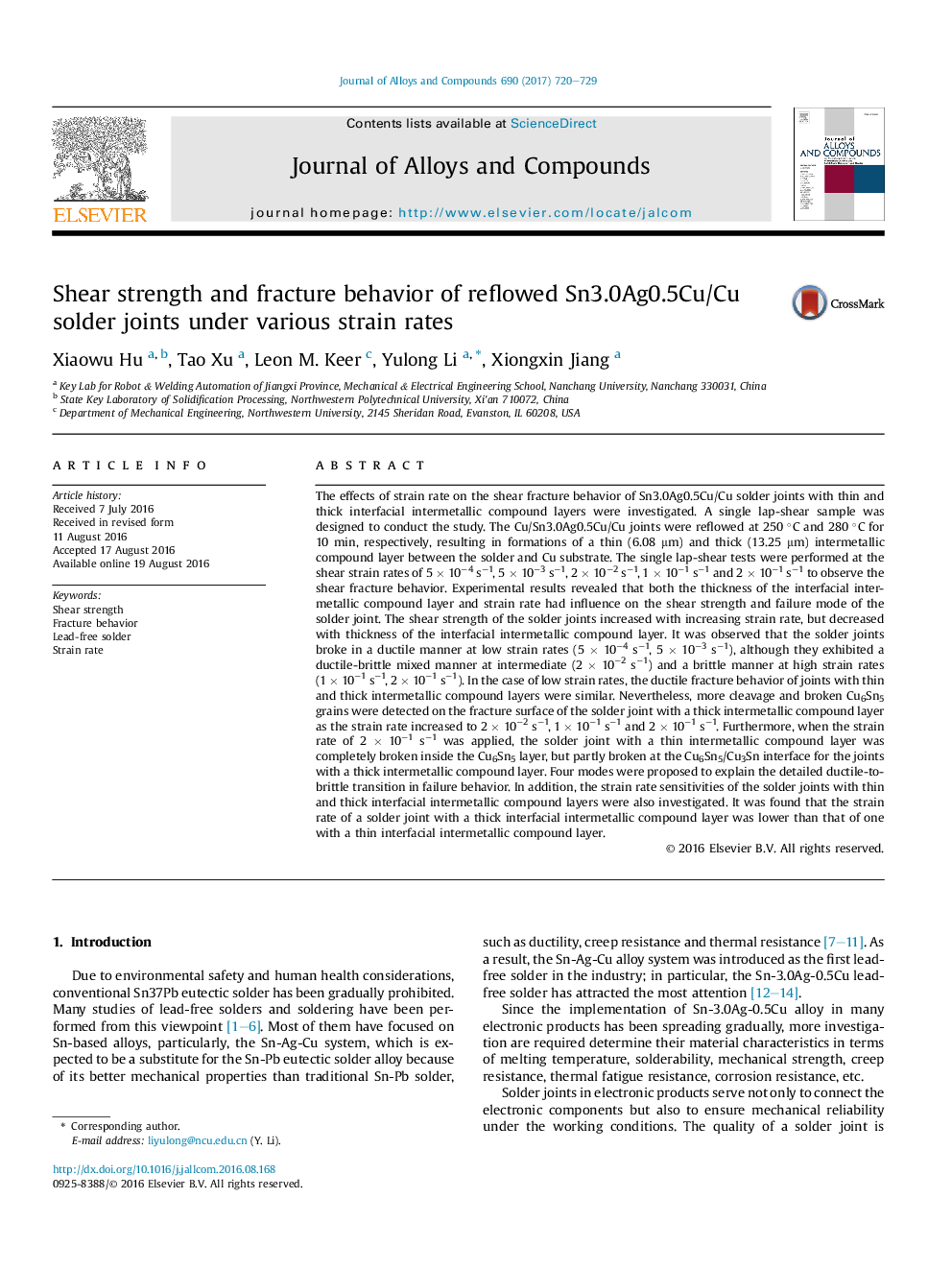| کد مقاله | کد نشریه | سال انتشار | مقاله انگلیسی | نسخه تمام متن |
|---|---|---|---|---|
| 1604979 | 1516204 | 2017 | 10 صفحه PDF | دانلود رایگان |
عنوان انگلیسی مقاله ISI
Shear strength and fracture behavior of reflowed Sn3.0Ag0.5Cu/Cu solder joints under various strain rates
دانلود مقاله + سفارش ترجمه
دانلود مقاله ISI انگلیسی
رایگان برای ایرانیان
کلمات کلیدی
موضوعات مرتبط
مهندسی و علوم پایه
مهندسی مواد
فلزات و آلیاژها
پیش نمایش صفحه اول مقاله

چکیده انگلیسی
The effects of strain rate on the shear fracture behavior of Sn3.0Ag0.5Cu/Cu solder joints with thin and thick interfacial intermetallic compound layers were investigated. A single lap-shear sample was designed to conduct the study. The Cu/Sn3.0Ag0.5Cu/Cu joints were reflowed at 250 °C and 280 °C for 10 min, respectively, resulting in formations of a thin (6.08 μm) and thick (13.25 μm) intermetallic compound layer between the solder and Cu substrate. The single lap-shear tests were performed at the shear strain rates of 5 Ã 10â4 sâ1, 5 Ã 10â3 sâ1, 2 Ã 10â2 sâ1, 1 Ã 10â1 sâ1 and 2 Ã 10â1 sâ1 to observe the shear fracture behavior. Experimental results revealed that both the thickness of the interfacial intermetallic compound layer and strain rate had influence on the shear strength and failure mode of the solder joint. The shear strength of the solder joints increased with increasing strain rate, but decreased with thickness of the interfacial intermetallic compound layer. It was observed that the solder joints broke in a ductile manner at low strain rates (5 Ã 10â4 sâ1, 5 Ã 10â3 sâ1), although they exhibited a ductile-brittle mixed manner at intermediate (2 Ã 10â2 sâ1) and a brittle manner at high strain rates (1 Ã 10â1 sâ1, 2 Ã 10â1 sâ1). In the case of low strain rates, the ductile fracture behavior of joints with thin and thick intermetallic compound layers were similar. Nevertheless, more cleavage and broken Cu6Sn5 grains were detected on the fracture surface of the solder joint with a thick intermetallic compound layer as the strain rate increased to 2 Ã 10â2 sâ1, 1 Ã 10â1 sâ1 and 2 Ã 10â1 sâ1. Furthermore, when the strain rate of 2 Ã 10â1 sâ1 was applied, the solder joint with a thin intermetallic compound layer was completely broken inside the Cu6Sn5 layer, but partly broken at the Cu6Sn5/Cu3Sn interface for the joints with a thick intermetallic compound layer. Four modes were proposed to explain the detailed ductile-to-brittle transition in failure behavior. In addition, the strain rate sensitivities of the solder joints with thin and thick interfacial intermetallic compound layers were also investigated. It was found that the strain rate of a solder joint with a thick interfacial intermetallic compound layer was lower than that of one with a thin interfacial intermetallic compound layer.
ناشر
Database: Elsevier - ScienceDirect (ساینس دایرکت)
Journal: Journal of Alloys and Compounds - Volume 690, 5 January 2017, Pages 720-729
Journal: Journal of Alloys and Compounds - Volume 690, 5 January 2017, Pages 720-729
نویسندگان
Xiaowu Hu, Tao Xu, Leon M. Keer, Yulong Li, Xiongxin Jiang,